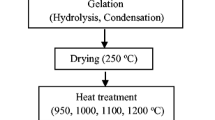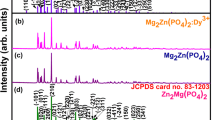Abstract
Dy2(WO4)3 powders were synthesized through liquid-phase reaction. The structure transformation of Dy2(WO4)3 powders were analyzed by differential scanning calorimetry (DSC), X-ray diffractometer (XRD) and Fourier transform infrared spectroscopy (FTIR). The optical absorption and photoluminescence properties were characterized by UV-vis-infra diffuse reflectance spectra and fluorescence spectra. The Dy2(WO4)3 host could absorb deep UV light and transfer the energy of UV light to Dy3+ ions, which convert the high-energy UV light to blue light (482 nm, 4 F 9/2→6 H 15/2) and yellow light (547 nm, 4 F 9/2→6 H 13/2). The Dy2(WO4)3 powders could also absorb near UV light and exhibit blue and yellow emissions near 482 and 547 nm, respectively. Heat treating promoted the crystallization and regulated the micro-structure of Dy2(WO4)3 hosts. The bands of W-Od anti-symmetric stretching vibration exhibited red shift with the increasing of sintering temperature. The W-Ob-W groups tended to combine with each other to form W-Oc-W groups after heat treating. These regulation of micro-structure had influence on the luminescent color of Dy2(WO4)3. The samples could emit yellow-green, white-yellow and white light under the excitation of 350 nm after being treated at 600, 800 and 1 000 °C, respectively. The prepared Dy2(WO4)3 powders have potential to act as UV absorber for solar cell to improve the conversion efficiency and also exhibit potential for white light LED.
Similar content being viewed by others

References
K Kawano, B C Hong, K Sakamoto, et al. Improvement of the Conversion Efficiency of Solar Cell by Rare Earth Ion[J]. Optical Materials, 2009, 31(9): 1 353–1 356
Li Yanzhen, Shi Dongmei, Qian Qi, et al. Influence of Yb3+ and Ce3+ on the Spectroscopic Properties of Er3+-doped Bi2O3-Ga2O3-PbO-GeO2 Glass[J]. Journal of Wuhan University of Technology, 2010(05): 20–23
Jiang Feng, Xiang Zhoudan, Bai Lan, et al. Research on Synthesis Techniques of Preparation of SrAl2O4:Eu2+,Dy3+ Luminescent Material by Low Temperature Combustion[J]. Journal of Wuhan University of Technology, 2009(20): 15–18
A Jones, P R Slater, M S Islam. Local Defect Structures and Ion Transport Mechanisms in the Oxygen-Excess Apatite La9.67 (SiO4)6 O2.5[J]. Chem. Mat., 2008, 20(15): 5 055–5 060
W M Tan, C H Lu, Y R Ni, et al. Unique Photoluminescence in SiO2:Sm Prepared by Sol-Gel Process[J]. Chinese Journal of Inorganic Chemistry, 2009, 25(4): 635–640
J S Liao, B Qiu, H S Lai. Synthesis and Luminescence Properties of Tb3+:NaGd(WO4)2 Novel Green Phosphors[J]. Journal of Luminescence, 2009, 129(7): 668–671
J Chen, X H Gong, Y F Lin, et al. Synthesis and Spectral Property of Pr3+-Doped Tungstate Deep Red Phosphors[J]. J. Alloy. Compd., 2010, 492(1-2): 667–670
S L Baldochi, F R. Silva, J R De Moraes, et al. Synthesis and Growth of Materials for Solid State Lasers: Nd:YLF and Nd:LLW Single Crystal Fibers[J]. Journal of Crystal Growth, 2011, 317(1): 4–7
Z L Wang, H B Liang, Q Wang, et al. Luminescent Properties of Tb3+ Activated Double Molybdates and Tungstates[J]. Materials Science and Engineering B-Advanced Functional Solid-State Materials, 2009, 164(2): 120–123
R Krupke, F Hennrich, O Hampe, et al. Near-infrared Absorbance of Single-Walled Carbon Nanotubes Dispersed in Dimethylformamide[J]. Journal of Physical Chemistry B, 2003, 107(24): 5 667–5 669
Q Peng, Y Dong, Z Deng, et al. Low-Temperature Elemental-Direct-Reaction Route to II–VI Semiconductor Nanocrystalline ZnSe and CdSe[J]. Inorganic Chemistry, 2001, 40(16): 3 840–3 841
J S Liao, B Qiu, H R Wen, et al. Photoluminescence Green in Microspheres of CaWO4:Tb3+ Processed in Conventional Hydrothermal[J]. Optical Materials, 2009, 31(10): 1 513–1 516
Z J Zhang, J L Yuan, H H Chen, et al. Vacuum Ultraviolet Spectroscopic Properties of Rare Earth (RE) (RE = Eu, Tb, Dy, Sm, Tm)-Doped K2GdZr(PO4)3 Phosphate[J]. Solid State Sciences, 2009, 11(2): 549–555
X Y Sun, J C Zhang, X G Liu,et al. Enhanced Luminescence of Ca3B2O6: Dy3+ Phosphors by Na+-codoping for LED Applications[J]. Physica B-Condensed Matter, 2011, 406(21): 4 089–4 093
S Sen, J F Stebbins. Structural Role of Nd3+ and Al3+ Cations in SiO2 Glass: A 29Si MAS-NMR Spin-Lattice Relaxation, 27Al NMR and EPR Study[J]. Journal of Non-Crystalline Solids, 1995, 188(1–2): 54–62
Author information
Authors and Affiliations
Corresponding author
Additional information
Funded by Scientific Development Foundation for Nanjing (No. 2012ZD002), the Scientific Research Foundation of Doctor (No. jit-b-201222), the Project Funded by the Priority Academic Program Development of Jiangsu Higher Education Institutions, the Climbing Project for Scholars with Innovation of Jiangsu Province (No.SBK200910148), and the National Natural Science Foundation of China (No.20901040/B0111)
Rights and permissions
About this article
Cite this article
Zhang, W., Lu, C., Ni, Y. et al. Heat treatment temperature effect on the microstructure and optical properties of Dy2(WO4)3 powders. J. Wuhan Univ. Technol.-Mat. Sci. Edit. 28, 862–867 (2013). https://doi.org/10.1007/s11595-013-0783-5
Received:
Accepted:
Published:
Issue Date:
DOI: https://doi.org/10.1007/s11595-013-0783-5



